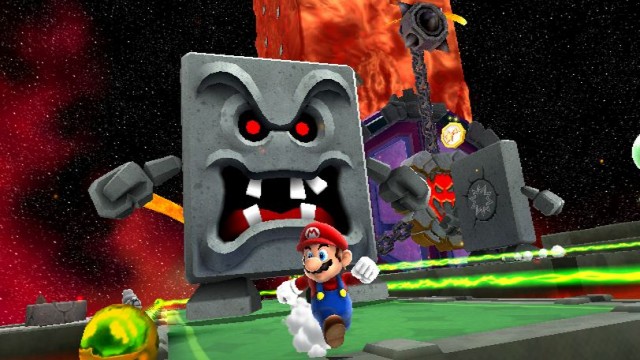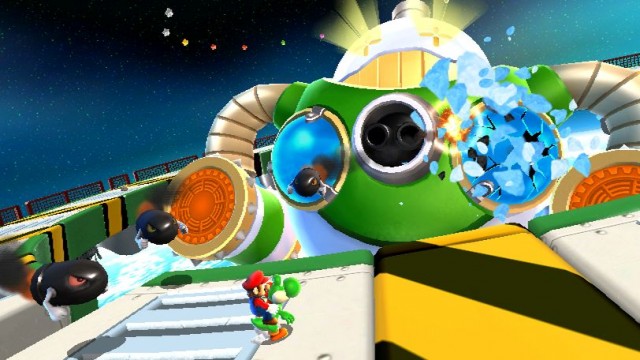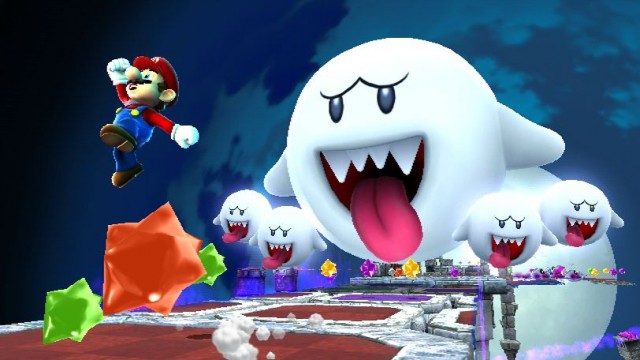Gameplay that is both familiar and fresh; outstanding graphics and sound; glorious new power-ups (including Yoshi)
Nothing worth mentioning
To say that Super Mario Galaxy 2 suffers from critical hype is an understatement. Galaxy 2 is the sequel to the critical and commercial hit Super Mario Galaxy and has thus far earned tremendous praise in the press, including a pair of perfect scores from the notoriously stingy corporate sites, IGN and GameSpot. As it turns out, this hype is justified, as Super Mario Galaxy 2 is perhaps the best game Nintendo has ever made.
Like its predecessor, Super Mario Galaxy 2 is a platformer that borrows heavily from Mario lore. The plot is the same as always, with Bowser kidnapping Peach and Mario out to save her. (Although billed as a sequel, there is no real plot connection between this game and the first one.) Along the way, the plumber travels from world to world, jumping and hurtling through space, all while collecting stars, coins, and various power-ups. Old favorites like invincibility stars, life mushrooms, and fire flowers join recent additions like bee suits and spring mushrooms. Additionally, Galaxy reintroduces Yoshi very early on and puts the dinosaur to good use in multiple levels throughout the adventure.
The hub of the action is the Starship Mario, a giant face-shaped rock that moves from world to world. Unlike the first Super Mario Galaxy — and Super Mario 64 before it — there is no hunting around a giant hub for the next location. Instead, the game employs a side-scrolling level map as was found in New Super Mario Bros. Wii and Super Mario Bros. 3. It’s a change for the better, as getting into the action at the start of a play session is much simpler. For those craving hub world action, though, don’t fret; Mario can step away from the steering wheel and explore his new ship at any time.

Despite borrowing heavily from the well-worn Mario past, the game keeps things fresh in ways no Mario game has ever achieved. Each level in Galaxy 2 is unique, both visually and functionally, and each seems to somehow introduce a new gameplay mechanic or experience that did not heretofore exist. A level might introduce a new power-up, like the the cloud mushroom (which lets Mario create cloud platforms) or rock mushroom (which lets Mario transform into a powerful rolling boulder). Yoshi might get access to special fruit that let him float upwards or illuminate invisible platforms. A level might introduce some strange new platform or a giant boss or a side-scrolling experience or a new extra to be found back on Mario’s starship. It’s hard to think of any platformer that is as varied as this one, especially given its significant length.
Nintendo nails the game insofar as the fundamentals are concerned. The controls are very similar to the first game and remain just as responsive, with IR and motion put to use in ways that are immersive without being overbearing. Yoshi controls are different and take a little getting used to but they work well, especially putting IR to use as the aiming device for Yoshi’s tongue. The graphics are on the top end of Wii titles and if there are any loading times, Nintendo conceals them brilliantly. The sound is fully orchestrated and includes several new original pieces and brilliant remixes of old Mario titles.

Perhaps the best judge of a game’s greatness is its attention to the little things, and in this sense Galaxy 2 does not disappoint. For example, the title screen comes quickly, with no annoying developer credits or introductory videos, allowing players to get right into the action each time the game is loaded. As mentioned before, the game takes great pains to introduce new elements at every turn, with an attention to pacing that has rarely been seen elsewhere. The game offers an ingenious approach to differentiated difficulty, offering easy quests — and the option for assistive co-op — for those who need the help, and deviously hard green stars for those who really want to be challenged.
The game also shows evidence of tweaking from its predecessor. The fire flower, once too short to really be enjoyed, appears to have a longer life span than before. The camera seems improved. The art style is more varied. Unnecessary elements, like the Rosalinda subplot, have been marginalized or eliminated entirely. Co-op is now much more meaningful: a second player now controls a star character that can pin down enemies, kill enemies with a spin attack, and even pick up and deliver items such as coins and 1-up mushrooms.

No game is “perfect.” Every game has at least minor flaws, and Super Mario Galaxy 2 has a couple, but they are so negligible that they feel like nitpicking. On the other hand, it’s clear that Nintendo did everything possible to tweak, enhance, and improve this game over its predecessor, all while trying to create an experience that was at once familiar and fresh. Additions like Yoshi, Rock Mario, and green stars are exemplars of that effort. If a “perfect score” for a game represents the very best that a game developer could reasonably be asked to do given the constraints of the hardware, Super Mario Galaxy 2 deserves to be in that elite territory.




 ShareThis
ShareThis







Wow… those screens really look jaggy. Not something I noticed when playing through my copy of the game. Of course, I’m playing on a standard-def TV, which might be the difference.
AA (antialiasing) can be done as an pre or post process to graphics. I believe on most Wii games, it is an post process. Meaning, that in still images, they will look much more jaggy. It doesn’t look this bad on my 55 incher at home. I do get it upconverted through my receiver, however, so that may help the jaggies a bit.
This may be my favorite 3D Mario. Definitely deserves the high score.
Yeah it definitely deserves the score, but I honestly don’t think it is as good as the original. Nothing in Galaxy 2 is as hard as the purple coin challenges on the Battlerock and Dreadnaught galaxies. Plus I think the levels were much more memorable in the first one.
It’s simply a masterpiece. A musthave.